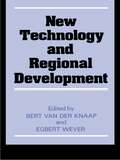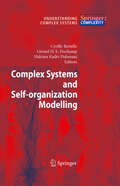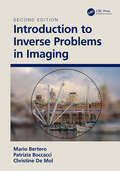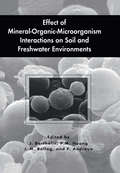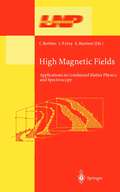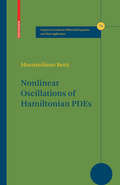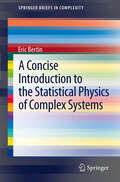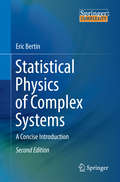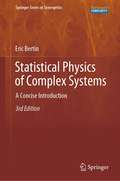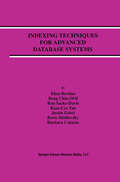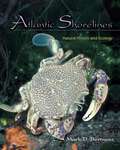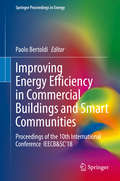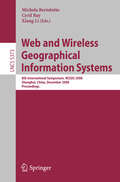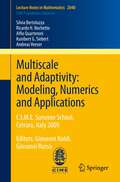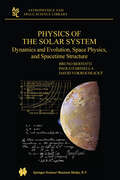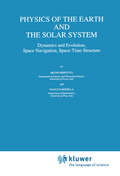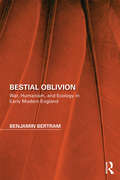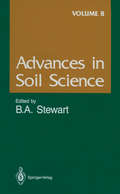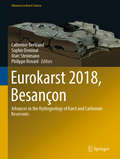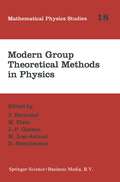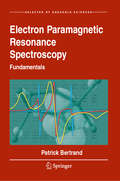- Table View
- List View
New Technology and Regional Development
by Bert Van Der Knapp Egbert WeverFirst Published in 2004. Routledge is an imprint of Taylor & Francis, an informa company.
Complex Systems and Self-organization Modelling (Understanding Complex Systems)
by Cyrille Bertelle Gérard H. E. Duchamp Hakima Kadri-DahmaniIntroduction to Inverse Problems in Imaging
by M. Bertero P. Boccacci Christine De MolFully updated throughout and with several new chapters, this second edition of Introduction to Inverse Problems in Imaging guides advanced undergraduate and graduate students in physics, computer science, mathematics and engineering through the principles of linear inverse problems, in addition to methods of their approximate solution and their practical applications in imaging. This second edition contains new chapters on edge-preserving and sparsity-enforcing regularization in addition to maximum likelihood methods and Bayesian regularization for Poisson data. The level of mathematical treatment is kept as low as possible to make the book suitable for a wide range of students from different backgrounds, with readers needing just a rudimentary understanding of analysis, geometry, linear algebra, probability theory, and Fourier analysis. The authors concentrate on presenting easily implementable and fast solution algorithms, and this second edition is accompanied by numerical examples throughout. It will provide readers with the appropriate background needed for a clear understanding of the essence of inverse problems (ill-posedness and its cure) and, consequently, for an intelligent assessment of the rapidly growing literature on these problems. Key features: Provides an accessible introduction to the topic while keeping mathematics to a minimum Interdisciplinary topic with growing relevance and wide-ranging applications Accompanied by numerical examples throughout
Introduction to Inverse Problems in Imaging
by M. Bertero P. Boccacci Christine De MolFully updated throughout and with several new chapters, this second edition of Introduction to Inverse Problems in Imaging guides advanced undergraduate and graduate students in physics, computer science, mathematics and engineering through the principles of linear inverse problems, in addition to methods of their approximate solution and their practical applications in imaging. This second edition contains new chapters on edge-preserving and sparsity-enforcing regularization in addition to maximum likelihood methods and Bayesian regularization for Poisson data. The level of mathematical treatment is kept as low as possible to make the book suitable for a wide range of students from different backgrounds, with readers needing just a rudimentary understanding of analysis, geometry, linear algebra, probability theory, and Fourier analysis. The authors concentrate on presenting easily implementable and fast solution algorithms, and this second edition is accompanied by numerical examples throughout. It will provide readers with the appropriate background needed for a clear understanding of the essence of inverse problems (ill-posedness and its cure) and, consequently, for an intelligent assessment of the rapidly growing literature on these problems. Key features: Provides an accessible introduction to the topic while keeping mathematics to a minimum Interdisciplinary topic with growing relevance and wide-ranging applications Accompanied by numerical examples throughout
Effect of Mineral-Organic-Microorganism Interactions on Soil and Freshwater Environments
by J. Berthelin P. M. Huang J. M. Bollag F. AndreuxThe Working Group M.O. (Interactions of soil minerals with organic components and microorganisms) (WGMO) of the International Soil Science Society (ISSS) was founded in 1990 at the 14th World Congress of Soil Science (Kyoto, Japan), with Professor P.M. Huang being the Chairman. Since then, the Working Group M.O. has served as a forum to bring together soil chemists, soil mineralogists, soil microbiologists, soil biochemists, soil physi cists and environmental, ecological, and health scientists. The objective of the Working Group M.O. is to promote research, teaching, and also the exchange of technology concerning the knowledge and the impact of the interactions between minerals-organics and microorganisms on environmental quality, agricultural sustainability, and ecosystem "health". This group is first a scientific group as defined just previously, but it also intends to develop exchange and transfer between scientists and engineers. The first International Meeting organized by Professor P. M. Huang, was held in Edmonton, Canada, in August 1992, where 87 papers were presented by scientists from 20 countries. Following this meeting, a two volume book was edited by P. M. Huang, J. Berthelin, J.-M. Bollag, W. B. McGill, and A. L. Page, entitled "Environmental impact of soil component interaction" : Volume I "Natural and anthropogenic organic-volume II "Metals, other inorganic and microbial activities", and published by c.R.C. Lewis Pub lishers (1995).
High Magnetic Fields: Applications in Condensed Matter Physics and Spectroscopy (Lecture Notes in Physics #595)
by Claude Berthier Laurent P. Levy Gerard MartinezThis book is addressed to all scientists interested in the use of high magnetic ?elds and in the use of high-?eld facilities around the world. In particular it will help young scientists and newcomers to the topic to gain a better understanding in areas such as condensed matter physics, in which the magnetic ?eld plays a key role either as a parameter controlling the Hamiltonian, or as an experimental tool to probe the underlying mechanism. This concerns mostly strongly correlated and (or) low dimensional systems. Rather than covering all these subjects in detail, the philosophy here is to give essential physical concepts in some of the most active ?elds, which have been quickly growing in the last ten to twenty years. Besides its role as a physical parameter in condensed matter physics, a large magnetic ?eld is essential to Electron Paramagentic Resonance (EPR) and Nuclear Magnetic Resonance (NMR) spectroscopies. The state of art of high resolution NMRin liquids and solids and high frequency EPRapplied to ?elds like chemistry and biology are also reviewed in this volume. The ?rst series of chapters is devoted to the integer and the Fractional Qu- tum Hall E?ects (FQHE) in two-dimensional electron systems. C. Glattli brushes an historical background and a comprehensive review of transport phenomena in these systems, including recent developments on the mesoscopic electronic transport at the edges of quantum Hall samples, chiral Luttinger liquids and fractional excitations. R.
Nonlinear Oscillations of Hamiltonian PDEs (Progress in Nonlinear Differential Equations and Their Applications #74)
by Massimiliano BertiMany partial differential equations (PDEs) that arise in physics can be viewed as infinite-dimensional Hamiltonian systems. This monograph presents recent existence results of nonlinear oscillations of Hamiltonian PDEs, particularly of periodic solutions for completely resonant nonlinear wave equations. The text serves as an introduction to research in this fascinating and rapidly growing field. Graduate students and researchers interested in variational techniques and nonlinear analysis applied to Hamiltonian PDEs will find inspiration in the book.
A Concise Introduction to the Statistical Physics of Complex Systems (SpringerBriefs in Complexity)
by Eric BertinThis concise primer (based on lectures given at summer schools on complex systems and on a masters degree course in complex systems modeling) will provide graduate students and newcomers to the field with the basic knowledge of the concepts and methods of statistical physics and its potential for application to interdisciplinary topics. Indeed, in recent years, statistical physics has begun to attract the interest of a broad community of researchers in the field of complex system sciences, ranging from biology to the social sciences, economics and computer science. More generally, a growing number of graduate students and researchers feel the need to learn some basic concepts and questions originating in other disciplines without necessarily having to master all of the corresponding technicalities and jargon. Generally speaking, the goals of statistical physics may be summarized as follows: on the one hand to study systems composed of a large number of interacting ‘entities’, and on the other to predict the macroscopic (or collective) behavior of the system considered from the microscopic laws ruling the dynamics of the individual ‘entities’. These two goals are, to some extent, also shared by what is nowadays called ‘complex systems science’ and for these reasons, systems studied in the framework of statistical physics may be considered as among the simplest examples of complex systems—allowing in addition a rather well developed mathematical treatment.
Statistical Physics of Complex Systems: A Concise Introduction (Springerbriefs In Complexity Ser.)
by Eric BertinThis course-tested primer provides graduate students and non-specialists with a basic understanding of the concepts and methods of statistical physics and demonstrates their wide range of applications to interdisciplinary topics in the field of complex system sciences, including selected aspects of theoretical modeling in biology and the social sciences. Generally speaking, the goals of statistical physics may be summarized as follows: on the one hand to study systems composed of a large number of interacting units, and on the other to predict the macroscopic, collective behavior of the system considered from the perspective of the microscopic laws governing the dynamics of the individual entities. These two goals are essentially also shared by what is now called 'complex systems science,' and as such, systems studied in the framework of statistical physics may be considered to be among the simplest examples of complex systems – while also offering a rather well developed mathematical treatment. The second edition has been significantly revised and expanded, featuring in particular three new chapters addressing non-conserved particles, evolutionary population dynamics, networks, properties of both individual and coupled simple dynamical systems, and convergence theorems, as well as short appendices that offer helpful hints on how to perform simple stochastic simulations in practice. Yet, the original spirit of the book – to remain accessible to a broad, non-specialized readership – has been kept throughout: the format is a set of concise, modular and self-contained topical chapters, avoiding technicalities and jargon as much as possible, and complemented by a wealth of worked-out examples, so as to make this work useful as a self-study text or as textbook for short courses. From the reviews of the first edition: “… a good introduction to basic concepts of statistical physics and complex systems for students and researchers with an interest in complex systems in other fields … .” Georg Hebermehl, Zentralblatt MATH, Vol. 1237, 2012 “… this short text remains very refreshing for the mathematician.” Dimitri Petritis, Mathematical Reviews, Issue 2012k
Statistical Physics of Complex Systems: A Concise Introduction (Springer Series in Synergetics)
by Eric BertinThis third edition of Statistical Physics of Complex Systems has been expanded to provide more examples of applications of concepts and methods from statistical physics to the modeling of complex systems. These include avalanche dynamics in materials, models of social agents like road traffic or wealth repartition, the real space aspects of biological evolution dynamics, propagation phenomena on complex networks, formal neural networks and their connection to constraint satisfaction problems.This course-tested textbook provides graduate students and non-specialists with a basic understanding of the concepts and methods of statistical physics and demonstrates their wide range of applications to interdisciplinary topics in the field of complex system sciences, including selected aspects of theoretical modeling in biology and the social sciences. It covers topics such as non-conserved particles, evolutionary population dynamics, networks, properties of both individual and coupled simple dynamical systems, and convergence theorems, as well as short appendices that offer helpful hints on how to perform simple stochastic simulations in practice. The original spirit of the book is to remain accessible to a broad, non-specialized readership. The format is a set of concise, modular, and self-contained topical chapters, avoiding technicalities and jargon as much as possible, and complemented by a wealth of worked-out examples, so as to make this work useful as a self-study text or as textbook for short courses.
Indexing Techniques for Advanced Database Systems (Advances in Database Systems #8)
by Elisa Bertino Beng Chin Ooi Ron Sacks-Davis Kian-Lee Tan Justin Zobel Boris Shidlovsky Daniele AndronicoRecent years have seen an explosive growth in the use of new database applications such as CAD/CAM systems, spatial information systems, and multimedia information systems. The needs of these applications are far more complex than traditional business applications. They call for support of objects with complex data types, such as images and spatial objects, and for support of objects with wildly varying numbers of index terms, such as documents. Traditional indexing techniques such as the B-tree and its variants do not efficiently support these applications, and so new indexing mechanisms have been developed. As a result of the demand for database support for new applications, there has been a proliferation of new indexing techniques. The need for a book addressing indexing problems in advanced applications is evident. For practitioners and database and application developers, this book explains best practice, guiding the selection of appropriate indexes for each application. For researchers, this book provides a foundation for the development of new and more robust indexes. For newcomers, this book is an overview of the wide range of advanced indexing techniques. Indexing Techniques for Advanced Database Systems is suitable as a secondary text for a graduate level course on indexing techniques, and as a reference for researchers and practitioners in industry.
A Brief Natural History of Civilization: Why a Balance Between Cooperation & Competition Is Vital to Humanity
by Mark BertnessA compelling evolutionary narrative that reveals how human civilization follows the same ecological rules that shape all life on Earth Offering a bold new understanding of who we are, where we came from, and where we are going, noted ecologist Mark Bertness argues that human beings and their civilization are the products of the same self-organization, evolutionary adaptation, and natural selection processes that have created all other life on Earth. Bertness follows the evolutionary process from the primordial soup of two billion years ago through today, exploring the ways opposing forces of competition and cooperation have led to current assemblages of people, animals, and plants. Bertness’s thoughtful examination of human history from the perspective of natural history provides new insights about why and how civilization developed as it has and explores how humans, as a species, might have to consciously overrule our evolutionary drivers to survive future challenges.
Atlantic Shorelines: Natural History and Ecology
by Mark D. BertnessA comprehensive introduction to the natural history and intertidal ecology of East Coast shorelinesAtlantic Shorelines is an introduction to the natural history and ecology of shoreline communities on the East Coast of North America. Writing for a broad audience, Mark Bertness examines how distinctive communities of plants and animals are generated on rocky shores and in salt marshes, mangroves, and soft sediment beaches on Atlantic shorelines.The book provides a comprehensive background for understanding the basic principles of intertidal ecology and the unique conditions faced by intertidal organisms. It describes the history of the Atlantic Coast, tides, and near-shore oceanographic processes that influence shoreline organisms; explains primary production in shoreline systems, intertidal food webs, and the way intertidal organisms survive; sets out the unusual reproductive challenges of living in an intertidal habitat, and the role of recruitment in shaping intertidal communities; and outlines how biological processes like competition, predation, facilitation, and ecosystem engineering generate the spatial structure of intertidal communities.The last part of the book focuses on the ecology of the three main shoreline habitats—rocky shores, soft sediment beaches, and shorelines vegetated with salt marsh plants and mangroves—and discusses in detail conservation issues associated with each of them.
Atlantic Shorelines: Natural History and Ecology
by Mark D. BertnessA comprehensive introduction to the natural history and intertidal ecology of East Coast shorelinesAtlantic Shorelines is an introduction to the natural history and ecology of shoreline communities on the East Coast of North America. Writing for a broad audience, Mark Bertness examines how distinctive communities of plants and animals are generated on rocky shores and in salt marshes, mangroves, and soft sediment beaches on Atlantic shorelines.The book provides a comprehensive background for understanding the basic principles of intertidal ecology and the unique conditions faced by intertidal organisms. It describes the history of the Atlantic Coast, tides, and near-shore oceanographic processes that influence shoreline organisms; explains primary production in shoreline systems, intertidal food webs, and the way intertidal organisms survive; sets out the unusual reproductive challenges of living in an intertidal habitat, and the role of recruitment in shaping intertidal communities; and outlines how biological processes like competition, predation, facilitation, and ecosystem engineering generate the spatial structure of intertidal communities.The last part of the book focuses on the ecology of the three main shoreline habitats—rocky shores, soft sediment beaches, and shorelines vegetated with salt marsh plants and mangroves—and discusses in detail conservation issues associated with each of them.
Improving Energy Efficiency in Commercial Buildings and Smart Communities: Proceedings of the 10th International Conference IEECB&SC’18 (Springer Proceedings in Energy)
by Paolo BertoldiThese proceedings present fourteen peer-reviewed papers from the 10th International Conference on Improving Energy Efficiency in Commercial Buildings and Smart Communities, which was held March 21-22, 2018 in Frankfurt, Germany. This biannual conference aims to promote and diffuse the concept of energy efficiency in new and existing commercial buildings and to enlarge the market for low consumption and sustainable non-residential buildings. It also covers smart and sustainable districts, communities and cities, since energy systems efficiency and renewable energies are often optimized at the district or municipal level. The 2018 conference focused on advanced and innovative technologies to improve the energy efficiency of commercial buildings, communities and cities as well as the policies and measures by governments at various levels to improve energy efficiency. A particular focus was on Energy Service Companies (ESCOs). The conference addresses energy policy makers at international, national, and local level; academics, researchers and energy efficiency experts; ESCOs, utilities, buildings energy and environmental managers; buildings engineers and architects; and equipment manufacturers and commercial property investors.
Web and Wireless Geographical Information Systems: 8th International Symposium, W2GIS 2008, Shanghai, China, December 11-12, 2008. Proceedings (Lecture Notes in Computer Science #5373)
by Michela Bertolotto Cyril Ray Xiang LiThe 8th edition of the International Symposium on Web and Wireless Geograp- cal Information Systems (W2GIS 2008) was held in December 2008, in the vibrant city of Shanghai, China. This annual symposium aims at providing a forum for discussing advances on recent developments and research results in the ?eld of Web and wireless geographical information systems. Promoted from workshop to s- posium in 2005, W2GIS now represents a prestigious event within this dynamic research community. These proceedings contain the papers selected for presen- tion at this international event. For the 2008 edition, we received 38 submissions from 16 countries. All subm- ted papers were related to topics of interest to the symposium. Each paper received three reviews. Based on these reviews, 14 papers were selected for presentation and inclusion in the proceedings. The accepted papers are all of excellent quality and cover topics that range from mobile networks and location-based services, to contextual representation and mapping, to geospatial Web techniques, to object tracking in Web and mobile environments. We wish to thank all authors that contributed to this symposium for the high quality of their papers and presentations. Our sincere thanks go to Springer’s LNCS team. We would also like to acknowledge and thank the Program C- mittee members for the quality and timeliness of their reviews. Finally, many thanks to the Steering Committee members for providing continuous support and advice.
Multiscale and Adaptivity: C.I.M.E. Summer School, Cetraro, Italy 2009 (Lecture Notes in Mathematics #2040)
by Silvia Bertoluzza Ricardo H. Nochetto Alfio Quarteroni Kunibert G. Siebert Andreas VeeserThis book is a collection of lecture notes for the CIME course on "Multiscale and Adaptivity: Modeling, Numerics and Applications," held in Cetraro (Italy), in July 2009. Complex systems arise in several physical, chemical, and biological processes, in which length and time scales may span several orders of magnitude. Traditionally, scientists have focused on methods that are particularly applicable in only one regime, and knowledge of the system on one scale has been transferred to another scale only indirectly. Even with modern computer power, the complexity of such systems precludes their being treated directly with traditional tools, and new mathematical and computational instruments have had to be developed to tackle such problems. The outstanding and internationally renowned lecturers, coming from different areas of Applied Mathematics, have themselves contributed in an essential way to the development of the theory and techniques that constituted the subjects of the courses.
Physics of the Solar System: Dynamics and Evolution, Space Physics, and Spacetime Structure (Astrophysics and Space Science Library #293)
by B. Bertotti P. Farinella D. VokrouhlickyThis book is a direct sequel to: B. Bcrtotri and P. Farinclla, "Physics of the Earth and the Solar System, Dynamics and Evolution. Space Navigation. Spa cc-Time Structure" (Kluwcr Academic Publishers, 1990). Nearly 15 years af tcr its publication it became evident that the volume was in need of a new edition to keep up with the outstanding progress and the changing perspectives in this field. David Vokrouhlicky agreed to collaborate on the project and be the third author. On March 25, 2000. after a tong illness and a heart transplant. Paolo Farinella passed away. We then decided that. rather than aiming at a second edition, it made more sense to rewrite the book anew. While its basic content and the structure of the chapters are the same, important new topics have been added, including the extrasolar planetary systems, transneptunian objects. accurate determination of reference frames and new space projects. Greater relevance has been given to scmiquantitarive discussions before intro ducing formal developments: many figures have been added and updated and several errors corrected. More emphasis has given to the solar system, whereas geophysical topics have been left at a less advanced level. To mark this change the slightly differ ent title "Physics of the Solar System" was chosen. We wish to dedicate this book to the memory of Paolo Farinella. an out standing scientist, an invaluable collaborator and a dear friend.
Physics of the Earth and the Solar System: Dynamics and Evolution, Space Navigation, Space-Time Structure (Geophysics and Astrophysics Monographs #31)
by B. Bertotti Paolo FarinellaFrom the reviews: ".....The book is a very good balance between theory and applications, of analysis and synthesis, keeping always the focus on the comprehension of the physics ruling our planetary system. In summary, this represents both an excellent textbook for students and a fundamental reference, and encyclopedic summary current knowledge, for researchers in the Solar System field." (Alessandro Rossi, Celestial Mechanics and Dynamical Astronomy, 2005)
Bestial Oblivion: War, Humanism, and Ecology in Early Modern England (Perspectives on the Non-Human in Literature and Culture)
by Benjamin BertramAlthough war is a heterogeneous assemblage of the human and nonhuman, it nevertheless builds the illusion of human autonomy and singularity. Focusing on war and ecology, a neglected topic in early modern ecocriticism, Bestial Oblivion: War, Humanism, and Ecology in Early Modern England shows how warfare unsettles ideas of the human, yet ultimately contributes to, and is then perpetuated by, anthropocentrism. Bertram’s study of early modern warfare’s impact on human-animal and human-technology relationships draws upon posthumanist theory, animal studies, and the new materialisms, focusing on responses to the Anglo-Spanish War, the Italian Wars, the Wars of Religion, the colonization of Ireland, and Jacobean “peace.” The monograph examines a wide range of texts—essays, drama, military treatises, paintings, poetry, engravings, war reports, travel narratives—and authors—Erasmus, Machiavelli, Digges, Shakespeare, Marlowe, Coryate, Bacon—to show how an intricate web of perpetual war altered the perception of the physical environment as well as the ideologies and practices establishing what it meant to be human.
Bestial Oblivion: War, Humanism, and Ecology in Early Modern England (Perspectives on the Non-Human in Literature and Culture)
by Benjamin BertramAlthough war is a heterogeneous assemblage of the human and nonhuman, it nevertheless builds the illusion of human autonomy and singularity. Focusing on war and ecology, a neglected topic in early modern ecocriticism, Bestial Oblivion: War, Humanism, and Ecology in Early Modern England shows how warfare unsettles ideas of the human, yet ultimately contributes to, and is then perpetuated by, anthropocentrism. Bertram’s study of early modern warfare’s impact on human-animal and human-technology relationships draws upon posthumanist theory, animal studies, and the new materialisms, focusing on responses to the Anglo-Spanish War, the Italian Wars, the Wars of Religion, the colonization of Ireland, and Jacobean “peace.” The monograph examines a wide range of texts—essays, drama, military treatises, paintings, poetry, engravings, war reports, travel narratives—and authors—Erasmus, Machiavelli, Digges, Shakespeare, Marlowe, Coryate, Bacon—to show how an intricate web of perpetual war altered the perception of the physical environment as well as the ideologies and practices establishing what it meant to be human.
Advances in Soil Science (Advances in Soil Science #8)
by A. R. Bertrand J. C. Day R. J. Gibbs P. M. Huang R. E. Meyer A.S.P. Murthy R. I. Papendick J. B. Reid J. L. SteinerAdvances in Soil Science is a review series relevant to all areas of soil science. These reviews, intended primarily for scientists, teachers, and students of soil science, also provide technical background information for many additional workers and groups interested in our natural resources and man's influence on them. This is the eighth volume in the series with an international list of contributors from the United States, India, Canada and New Zealand. It contains four review chapters on the following subjects: factors affecting aluminum transformations in soil; soil productivity in dryland regions of developing countries; changes in soil structure under different cropping systems; properties and management of the depleted soils of India. These contributions present valuable information on a diversity of topics and serve as an excellent source of references.
Eurokarst 2018, Besançon: Advances in the Hydrogeology of Karst and Carbonate Reservoirs (Advances in Karst Science)
by Catherine Bertrand Sophie Denimal Marc Steinmann Philippe RenardThis book presents selected papers from the EuroKarst 2018 conference, which highlighted the latest advances in the field of Karst Hydrogeology and Carbonate Reservoirs. The event attracted more than 180 participants. From among their contributions, the papers were selected and subsequently reviewed by the scientific committee to ensure the highest possible quality.
Modern Group Theoretical Methods in Physics: Proceedings of the Conference in Honour of Guy Rideau (Mathematical Physics Studies #18)
by J. Bertrand M. Flato J. P. Gazeau M. Irac-Astaud Daniel SternheimerThis book contains the proceedings of a meeting that brought together friends and colleagues of Guy Rideau at the Université Denis Diderot (Paris, France) in January 1995. It contains original results as well as review papers covering important domains of mathematical physics, such as modern statistical mechanics, field theory, and quantum groups. The emphasis is on geometrical approaches. Several papers are devoted to the study of symmetry groups, including applications to nonlinear differential equations, and deformation of structures, in particular deformation-quantization and quantum groups. The richness of the field of mathematical physics is demonstrated with topics ranging from pure mathematics to up-to-date applications such as imaging and neuronal models. Audience: Researchers in mathematical physics.
Electron Paramagnetic Resonance Spectroscopy: Fundamentals
by Patrick BertrandAlthough originally invented and employed by physicists, electron paramagnetic resonance (EPR) spectroscopy has proven to be a very efficient technique for studying a wide range of phenomena in many fields, such as chemistry, biochemistry, geology, archaeology, medicine, biotechnology, and environmental sciences. Acknowledging that not all studies require the same level of understanding of this technique, this book thus provides a practical treatise clearly oriented toward applications, which should be useful to students and researchers of various levels and disciplines. In this book, the principles of continuous wave EPR spectroscopy are progressively, but rigorously, introduced, with emphasis on interpretation of the collected spectra. Each chapter is followed by a section highlighting important points for applications, together with exercises solved at the end of the book. A glossary defines the main terms used in the book, and particular topics, whose knowledge is not required for understanding the main text, are developed in appendices for more inquisitive readers.
